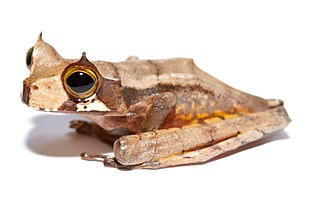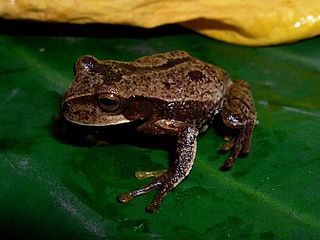
Gastrotheca is a genus of frogs in the family Hemiphractidae. They are found in Central America south of Costa Rica and in South America. Most species occur in the American Cordillera from southern Costa Rica to north-western Argentina. This genus makes up the bulk of marsupial frog diversity; formerly it was placed in the "Leptodactylidae" assemblage.

Eugenia María del Pino Veintimilla is a developmental biologist at the Pontificia Universidad Catolica del Ecuador in Quito. She was the first Ecuadorian citizen to be elected to the United States National Academy of Sciences (2006). She was awarded the 2019 Prize of the Latin American Society for Developmental Biology for her strong contributions to research in Ecuador, and in general to promoting Developmental Biology in Latin America.
Gastrotheca andaquiensis, commonly known as the Andes marsupial frog, is a species of frog in the family Hemiphractidae. It is found on the Amazonian slopes of Andes in southern Colombia and Ecuador.

Gastrotheca argenteovirens is a species of frog in the family Hemiphractidae. It is endemic to Colombia and occurs in the Colombian Massif, Cordillera Central, and Cordillera Occidental in the Quindío, Tolima, Valle del Cauca, Cauca, and Nariño Departments. Common name Popayan marsupial frog has been coined for it.

The horned marsupial frog, originally named Nototrema cornutum (Boulenger) after the first describer George Albert Boulenger in 1898), is a species of frog in the family Hemiphractidae. It is an arboreal species found in Colombia, Costa Rica, Ecuador and Panama. Its natural habitats are tropical moist lowland forests and montane cloud forests. It is threatened by habitat loss.

Gastrotheca dunni is a species of frog in the family Hemiphractidae. It is endemic to the northern part of the Cordillera Occidental in northern Antioquia, Colombia. The specific name dunni honors Emmett Reid Dunn, an American herpetologist. Common name Dunn's marsupial frog has been coined for it.

Gastrotheca excubitor is a species of frog in the family Hemiphractidae. It is endemic to southern Peru and occurs in the Amazonian slopes and crests of the Cordillera Oriental in the Cusco Region; records from the Cajamarca Region are likely erroneous. It is likely to include cryptic species. Common name Abra Acanacu marsupial frog has been coined for it.
Gastrotheca gracilis, commonly known as the La Banderita marsupial frog, is a species of frog in the family Hemiphractidae. It is found in northwestern Argentina and possibly Bolivia.

Gastrotheca guentheri is a species of frog in the family Hemiphractidae. It is found in the Andes of Colombia and Ecuador. Gastrotheca guentheri is the only known frog with true teeth in both of its jaws, as indicated by the name of the genus it originally typified, Amphignathodon, described by George Albert Boulenger in 1882.

Gastrotheca monticola is a species of frog in the family Hemiphractidae. It is endemic to Peru; records from Ecuador probably refer to other species. Gastrotheca lojana was formerly considered a subspecies of this species, but is now treated as a full species.
Gastrotheca nicefori is a species of frog in the family Hemiphractidae. It is found in the Andes of Colombia, on the Andean slopes of northern Venezuela, and in the highlands of eastern and central Panama.
Gastrotheca ochoai is a species of frog in the family Hemiphractidae. It is endemic to southern Peru and occurs in the interandean valleys on the eastern face of the Andes. The specific name ochoai honors Oscar Ochoa Mendieta, a biology professor from the National University of Saint Anthony the Abbot in Cuzco who helped the species descriptors during the field work. Common name Chilca marsupial frog has been coined for this species.

Gastrotheca ovifera is a species of frog in the family Hemiphractidae. It is endemic to northern Venezuela and is known from the Venezuelan Coastal Range, including Sierra de Aroa.
Gastrotheca piperata is a species of frog in the family Hemiphractidae.

The silver marsupial frog is a species of frog in the family Hemiphractidae. It is endemic to the Pacific slopes of Andes in northern and central Ecuador. It is a nocturnal, arboreal inhabitant of cloud forests that can also be found in forest edge and secondary, degraded habitats. It is closely associated with arboreal bromeliads. It is threatened by habitat loss.
Gastrotheca testudinea is a species of frog in the family Hemiphractidae. It has a widespread latitudinal range along the eastern (Amazonian) slopes of the Andes of Ecuador, Peru, and Bolivia.
Gastrotheca trachyceps is a species of frog in the family Hemiphractidae. It is endemic to the Cauca Department, Colombia, and is known from its type locality, Cerro Munchique in the Cordillera Occidental, and Vereda Santa Elena (Popayán) in the Cordillera Central. The specific name trachyceps is said to be derived from Greek trachy meaning "rough" and Latin ceps meaning "head", in reference to the rough appearance of the head. The proper word in Latin for head, however, is caput. The common name Cerro Munchique marsupial frog has been coined for it.
The Williamson's marsupial frog is a species of frog in the family Hemiphractidae. It is endemic to north-central coastal Venezuela and only known from its type locality, San Esteban in the state of Carabobo. It is a poorly known species that has not been collected since it was first described, based on a single specimen collected in 1920.
Gastrotheca zeugocystis is a species of frogs in the family Hemiphractidae. It is endemic to Peru and only known from its type locality on the Cordillera de Carpish, Huánuco Region. The specific name zeugocystis refers to the paired brood pouches in this species.

The Hemiphractidae are a family of frogs from South and Central America. Previously, this group had been classified as a subfamily (Hemiphractinae) under family Hylidae. More recent research classifies these genera into their own family, or sometimes into three separate families: Amphignathodontidae, Cryptobatrachidae, and Hemiphractidae. An active question still exists as to which of these groupings is more accurate.












